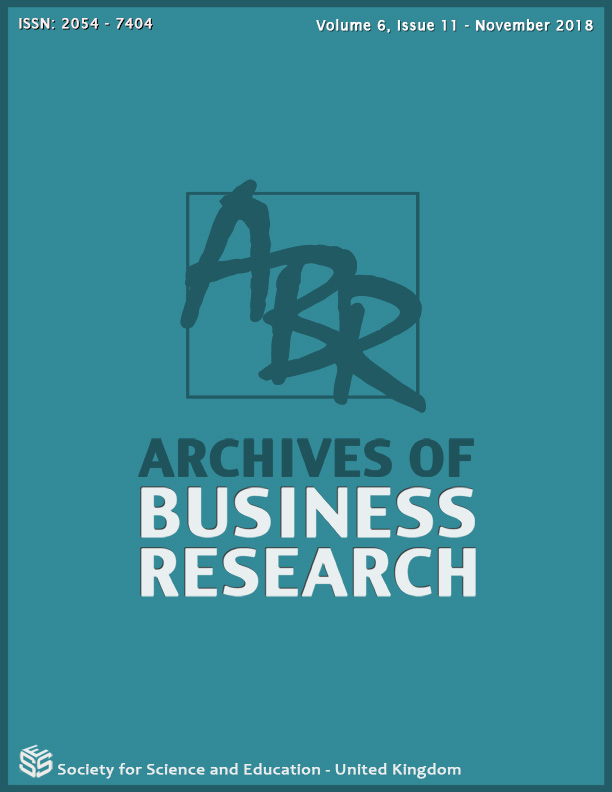Financial Ratio Analysis that Distinguishes Company Shares Indexed in LQ45 and the Non-LQ45 on the Indonesia Stock Exchange (Bursa Efek Indonesia)
DOI:
https://doi.org/10.14738/abr.611.5733Keywords:
Discriminant Analysis, LQ45, Financial RatioAbstract
The LQ45 index is the rank 45 ranking of the most liquid listed companies in the Indonesia Stock Exchange (BEI). By being in the LQ45 index, the company will be smoother in long-term funding because the shares circulating in the market tend to be more attractive if they are on the LQ45 index. This can be seen on the listing board for market activity published on the Indonesia Stock Exchange (BEI) website (www.idx.com). LQ45 companies tend to have high frequency of transaction values. To be indexed in LQ45, the Indonesia Stock Exchange does not specify how the financial conditions are the criteria of an LQ45 company. This study tries to look at the criteria of LQ45 companies through aspects of financial conditions. This is done by analyzing financial ratios in LQ45 companies and compare them with non-LQ45 companies with the same sector. In this research was using 6 financial ratio with 25 financial ratio indicators.
The number of samples in this study amounted to 230 companies then they are divided into 35 sample companies in the category of LQ45 companies and 195 companies in the category of non-LQ45 companies with the same sector. From discriminant analysis, the results of analysis can show whether there is a significant difference or not between the company's ROC indexed LQ45 and non-LQ45. The results output can be used as criteria for aspects of the financial situation that need to be observed by corporate stakeholders. The test results through discriminant analysis prove that there is a significant difference between LQ45 indexed company financial ratios and firms that are not indexed in LQ45 (non-LQ45). The results also prove that variables capable of distinguishing between companies indexed by LQ45 and those that are non-LQ45 from the 25 variables tested in this study include the dividend yield ratio (DYR), total assets turnover (TAT), per-share dividend (DPS), net working capital (NWC), market book value per share (MBVP), debt to equity ratio (DER), current ratio (CURRENT R), long term debt to equity (LTDE), account receivable turnover (ARTO ), operating profit margin (OPM), fixed assets turnover (FAT), and inventory turnover (ITO). The most significant variable that distinguishes between indexed company financial ratio in the LQ45 index and companies not listed on the LQ45 index is dividend yield ratio (DYR).
References
Nugroho, Mulyanto. 2018. The Effect of Asset Growth with Profitability and Company’s Value (Case Study: Coal Company was listed in Bursa Efek Indonesia during 2014-2016 Period). Archives of Business Research, Volume 6, No 10, pp. 347-358.
Sudana, I Made. 2015. Manajemen Keuangan Perusahaan. Edisi Kedua. Jakart : Erlangga.
Okezone.2016. Syarat Saham Untuk Masuk Index LQ45. Surel: http://economy.okezone.com/read/2016/02/01/278/1301908/syarat-saham-untuk-masuk-indeks-lq45. Senin 13 Maret 2017 Waktu 09.30.
Indonesia Stock Exchange. 2016. Manfaat Go Public. Surel : https://gopublic.idx.co.id/2016/06/22/manfaat-go-public/. Senin 13 Maret 2017 Waktu 19.08.
Prof.Dr.H.Imam Ghozali, Akt. 2016. Aplikasi Analisis Multivariete Program IBM SPSS 23. Penerbit: Universitas Diponegoro, Semarang.
Raza Ali, dkk. 2012. A Comparison of Financial Performance in Investment Banking Sector in Pakistan. Penerbit: Center For Promoting Ideas (CPI).Internasional Journals Of Business and Social Science, Vol.2 No.9 pp 72-81.
Hassan Mobeen Alam, dkk. 2012. A Financial Performance Comparison of Public Vs Private Banks: The Case Of Commercial Banking Sector Of Pakistan. Penerbit: Center for Promoting Ideas (CPI). Journals Internasional of Business and Social Science, Vol.2 No.11 pp.56-54.
Ntow, dkk. 2012. A financial Performance Comparison Of Foreign Vs Local Banks in Ghana. Penerbit: Center For Promoting Ideas (CPI). Internasional Journals of Business and Social Science, Vol.3 No.21 pp 82-87.
Mobarek Asma, dkk. 2013. Comparative Performance Analysis Between Conventional and Islamic banks: Empirica Evidence From OIC Countries. Penerbit: Routledge. Journals Applied Economics, Vol.46, No.3, pp 253-270.
Debora, Novita dkk, 2015. Comparation Analysis Of Financial Performance Using CAMEL Method On PT.Bank Jateng and Pt. Bnak DKI. Penerbit: Fakultas Ekonomi Universitas Sam Rtaulangi Manado.Jurnal EMBA Vol.3 No.1 Hlm 1117-1128.
Z Rizki Eko, dkk. 2014. Analisis Posisi Kinerja Keuangan Antara Bank Syariah dan Bank Konvensional di Indonesia. Penerbit: Fakultas Ekonomi dan Bisnis Universitas Sam Ratulangi Manado.Jurnal EMBA Vol.2 No.4 Des 2014 pp.258-268.
Lailiyah Hidayatul Elliv, dkk. 2016. Analisis Perbandingan Kinerja Reksadana Syariah dan Reksadana Konvensional. Penerbit: Universitas Brawijaya Malang. Jurnal Administrasi Bisnis (JAB) Vol. 35 No.2 pp.114-121.
Ng Thomas.S, dkk. 2013. Applying Z-Score model to Distinguish Insolvent Contruction Companies in China. Penerbit: Elsevier. Journals Habitat Internasional, Vol.35, pp 599-607.
Budiwati, Hesti. 2012. Analisis Rasio Keuangan CAMEL Terhadap Prediksi Kepailitan Pada Bank Umum Swasta Nasional di Indonesia. Penerbit: STIE Widya Gama Lumajang. Jurnal WIGA Vol.2 No.2 pp.50-63.
Florenz C. Tugas. 2013. A Comparative Analysis Of The Financial Ratios Of Listed Firms Belonging to The Education Subsector in The Philippines For The Years 2009-2011. Penerbit: Center For Promoting Ideas (CPI). Internasional Journals of Business and Social Science, Vol.3 No.21 pp 72-81.
Yunita Irenne Manitik. 2013. Analisis Perbandingan Kinerja Keuangan Pada PT XL Axiata Tbk dan PT Indosat Tbk. Penerbit: Universitas Sam Ratulangi Manado. Jurnal EMBA Vol1 No.4 Des 2013 pp.1974-1982.
Kasmir. 2016. Analisis Laporan Keuangan. Penerbit: PT.Raja Grafindo Persada. Jakarta.
Hery, SE., M.Si. 2015. Analisis Lapoan Keuangan: Pendekatan Rasio Keuangan. Bandung, Penerbit: CAPS.
Werner R. Murhadi. 2013. Analisis Laporan Keuangan: Proyeksi dan Valuasi Saham. Penerbit: Salemba Empat Jakarta.
Mamduh M. Hanafi, Abdul Halim. 2016. Analisis Laporan Keuangan (Edisi 5). Yogyakart: UPP STIM YKPN.
Fahmi, Irham. 2013. Analisis Laporan Keuangan, Cetakan ke-2 Bandung. Penerbit: Alfabeta.
Sugiyono. 2016. Metode Penelitian Kuantitatif Kualitatif dan R&B. Bandung: Alfabeta.
Prawironegoro, Darsono, dkk. 2014. Manajemen Keuangan. Penerbit : Mitra Wacana Media.
V.Wiratna Sujarweni. 2014. SPSS Untuk Penelitian. Penerbit : Pustaka Baru.
Prof Ferdinand Augusty, DBA. Metode Penelitian Manajemen.Edisi 5 Semarang. Penerbit: Badan Penerbit Universitas Diponegoro.






